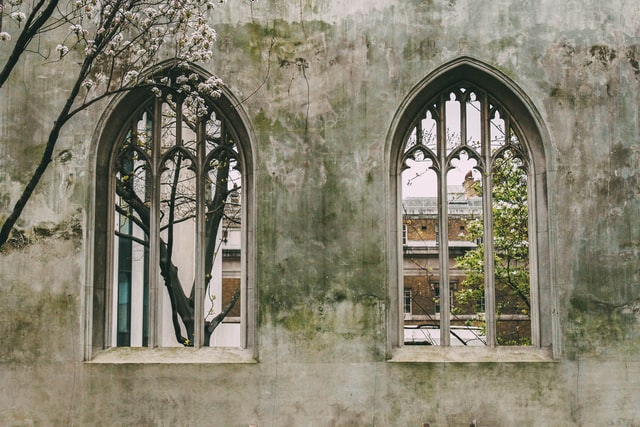I had planned on writing about stained-glass windows with their intricate patterns, the glowing mosaic of their stories, the emanations of their color and fire, but changed my mind, deciding to write about ordinary, unadorned windows. Windows are passed by, taken for granted amidst all the electronic pyrotechnics that stun and dazzle us. Besides the pull of glitzy technology vying for our attention, colonizing our range of vision, sometimes we pass by the beauty of the basic due to familiarity. Perhaps we should reconsider the wonder of windows; after all, they do open up enclosed spaces, offering us an entrance to something outside of ourselves.
In my church, high above the altar, past the rafters, there’s a large diamond-shaped window set beneath the vaulted ceiling. It mesmerizes the eyes, naturally drawing one’s gaze upwards with its spell of illumination. A tall pine tree framed against a rich blue sky and cream-colored clouds takes up the view, its limbs wavering, now and then, in the wind, sunlight brushing its needles, transforming dark green into glistening gold, offering a glimpse, beyond the clarity of glass, into transcendence, a hint of heaven.
Windows teach us to observe, fostering objectivity by framing a part of the world for consideration, naturally ushering us into a place somewhat distant from all the energy and motion of existence, inducing a posture of awareness, gently prodding us to meditate, to look from a place apart from the flow of things going on around us. Part of the way windows express this quality seems to be their inherent tendency to be objects of gentleness and quietness, filtering out harshness, the glare of bright days, the blare of noisy days, transforming cacophonies into muted symphonies.
Windows can also induce nostalgia, leading one back into the strangeness, the timelessness of memories, like those times as a child when I would lace my fingers on the back of that special white sofa, resting my chin on my knuckles, elbows akimbo, and stare, just stare out of our large living room window in a kind of dreamlike trance at the comedy of neighbors and the lyrical drama of nature. So many things seen while resting there, observing, such as the irony of autumn, of fiery leaves blossoming from the death of green; of the downfall of snowflakes weaving into a sparkling whiteness over the world; of the mirror-like puddles of spring pooling over yellowish-grass, reflecting dreams, and the hum of pollen-burdened bees, rippling through the heat of summer…
The diamond paned window in my church leads my eyes past the rafters and towards the cone-festooned pine tree, and sometimes beyond that, further up into a soft, blue and white jigsaw puzzle of sky. I think it’s fair to say that windows can definitely distract if we let them, offering us a convenient diversion from worshipping the Lord. There’s always a temptation to take something good (or bad) and make it the focus rather than God. Windows, whether beautiful, containing black tracery framing facets of color, or whether plain, lacking embellishment, can be used as a means to draw closer to God, as instruments, symbols and metaphors conveying much to the thoughtful soul about the greatness and majesty of our triune God.
Scott Schuleit enjoys teaching, preaching, the arts, theology, and spending time with his dear wife Christina. His poems and essays have appeared in various publications. He is the author of one book entitled: A Pernicious Correspondence: Letters from a Devil.
Photo credit: Photo by Eduard Militaru on Unsplash



